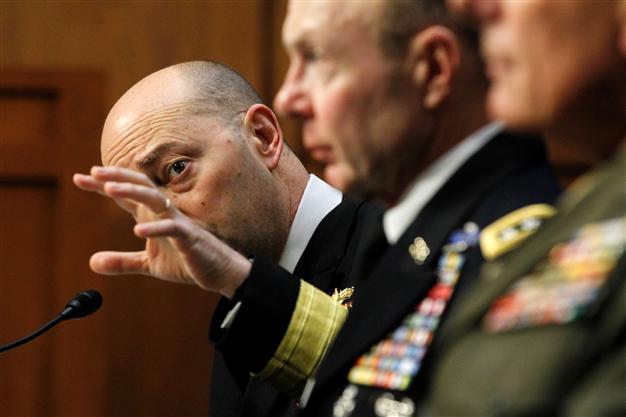Syria contingency plans under way: Top US general
WASHINGTON - The Associated Press

Adm. James G. Stavridis, commander, U.S. European Command and Supreme Allied Commander, Europe, left, testifies on Capitol Hill in Washington. AP photo
The top U.S. military commander in Europe said Tuesday that several NATO countries are working on contingency plans for possible military action to end the two-year civil war in Syria.“The Syrian situation continues to become worse and worse and worse,” Adm. James Stavridis, the commander of U.S. European Command, told the U.S. Senate Armed Services Committee. “No end in sight to a vicious civil war.”
Stavridis, who is retiring soon, said a number of NATO nations are looking at a variety of military operations to end the deadlock and assist the opposition forces, including using aircraft to impose a no-fly zone, providing military assistance to the rebels and imposing arms embargoes.
‘We are prepared if called upon’
As with U.S. and international involvement in Libya in 2011, a resolution from the U.N. Security Council and agreement among the alliance’s 28 members would be necessary before NATO assumes a military role in Syria, Stavridis said. “We are prepared if called upon to be engaged as we were in Libya,” he said.
But within individual member countries, the admiral said, “there’s a great deal of discussion” about lethal support to Syria, no-fly zones, arms embargoes and more. “It is moving individually within the nations, but it has not yet come into NATO as an overall NATO-type approach,” he said.
Senate Armed Services Chairman Carl Levin, a Democrat, asked whether there is any consideration of targeting Syria’s air defenses. Stavridis simply said yes. NATO has installed Patriot missile defense batteries in southern Turkey along the border with Syria that are also capable of shooting down aircraft. During an exchange with Sen. John McCain, a Republican, Stavridis said the Patriots could be positioned in such a way as to shoot down Syrian aircraft, and he indicated that doing so would be a powerful disincentive for pilots to fly in that area.
Turkey’s leaders have been “very emphatic” that the missiles be used only for defensive purposes, Stavridis said. To use the batteries for other missions, including attacking Syrian military aircraft, would require consensus among NATO’s members - “and we’re far from that,” Stavridis told the committee.
Stavridis said that his personal opinion is that providing military assistance to the Syrian opposition “would be helpful in breaking the deadlock and bringing down the Assad regime.”
‘Syria could end up like Balkans’
After Assad falls, Syria could end up like the Balkans, Stavridis told the Armed Services panel. “We saw in the Balkans 100,000 killed, 1 million people, 2 million people pushed across borders, (and) two significant wars, one in Bosnia, Herzegovina, one in Serbia, Kosovo,” Stavridis said.
“I think, unfortunately, that’s probably the future in Syria. It’s going to be after the Assad regime falls. I think, there’s going to be every potential for a great deal of revenge killing, interreligious conflict between various segments of the population, and it’s very difficult to see the pieces of Syria going back together again very easily.”
















